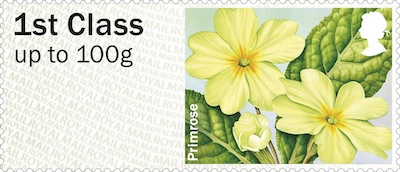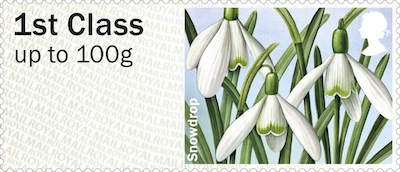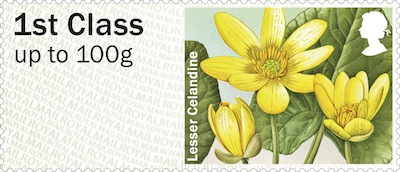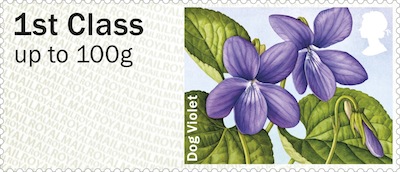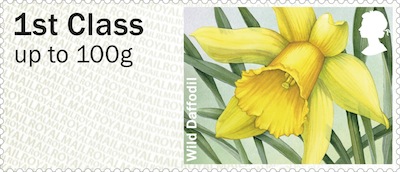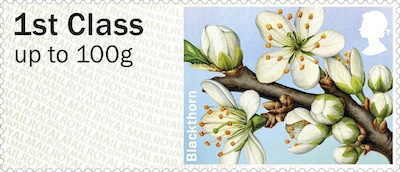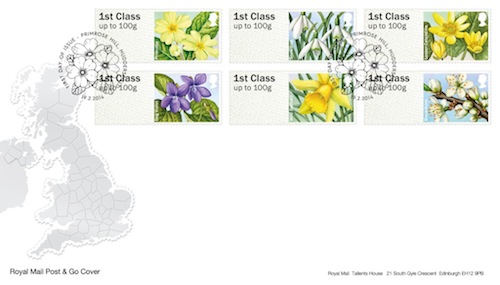Norvic Philatelics - GB New Stamps and Special Postmarks
Pictorial Faststamps: British Flora - Spring Blooms 19 February 2014
In 2014 the Post & Go pictorial
Faststamps series will be British Flora. The
three sets of Post & Go stamps being issued in 2014 will celebrate UK
wild flowers and plants.
Pictorial Post & Go stamps appear in machines in UK Post Offices for
defined periods of time in the year and this series is intended to provide
attractive stamps that are appropriate for the season in which they are
issued.
Spring Blooms
Springtime flowers mark the most profound change from the chilled depths of
winter to the rebirth of spring. Every year, no matter how harsh the winter,
spring flowers appear, sometimes peeking through the snow, reminding us that
a new season beckons. As well as being a source of great joy and injecting
colour into the countryside, these plants are vital sources of food for
animals that hibernate over winter in the UK.
Sadly, each year many of these species are reducing in number, victims of
changing weather and competition from more common species which thrive in
polluted ecosystems. You can help rare plants by reducing your impact on the
planet and joining a conservation organisation with a mission to protect
them.
There will be three sets of stamps in the year. The second set in
September will show Symbolic Flowers, and the third issue will show Winter
Greenery. Post & Go terminals allow customers to weigh their
letters and packets, pay for and print postage labels and stamps without the
need to visit the counter. The first Post & Go machine was trialled in
The Galleries Post Office® in Bristol in 2008. The labels will be used
in Post & Go machines at Post Offices around the country, and from new
Royal Mail Series II machines at Spring Stampex. The labels can be
obtained with 6 different service indicators: 1st class up to 100g & 1st
class Large up to 100g, Europe up to 20g, Worldwide up to 10g and 20g, and
the new Worldwide 40g. The stamps are dispensed singly or in strips of
up to 5 of the same value or various values. Thus there are 36 different
value/design combinations in total.
From top left: Primrose,
Snowdrop, Lesser Celandine, Dog Violet, Wild Daffodil,
Blackthorn.
|
The stamps in detail
Snowdrop (Galanthus nivalis)
can flower from January: Snowdrops have delicate flowers that hang down like
lanterns. Although appearing white, closer inspection reveals green tips on
the inner petals. The plants possess natural antifreeze compounds, enabling
them to thrive in harsh springs and even grow in snow.
Dog Violet (Viola riviniana): The heart-shaped
leaves of this plant can be seen throughout the year but in spring their
delicate purple blooms first appear. The flowers have large
backward-pointing spurs, full of nectar for pollinators emerging from winter
hibernation.
Wild daffodil (Narcissus pseudonarcissus): An
emblem of Wales and beloved by poets and artists, these swaying blooms with
a yellow ‘trumpet’ surrounded by six paler-yellow petals flower from
February to April. They are native to the south and west of the UK, growing
on woodland banks and in glades.
Primrose (Primula vulgaris): Primroses can form
dense carpets of yellow in woodland glades, hedgebanks and spring meadows.
Their name derives from being one of the first flowers of spring. The
flowers form two distinct types, ‘pins’ and ‘thrums’, which need each other
to cross-pollinate.
Lesser Celandine (Ranunculus ficaria):
Wordsworth’s favourite flower, called ‘spring messenger’ that reputedly
always flowers on 21 Feb. One of the true heralds of spring, these tiny
buttercups form yellow carpets in town parks, moist grasslands and
riverbanks. The flowers open their widest on sunny days when they are most
likely to be pollinated by passing insects.
Blackthorn (Prunus spinosa): A white flowering
plant, the Blackthorn is a common sight in UK hedgerows. These shrubs flower
before they grow leaves, giving them the whole summer to grow and ripen
their large sloe berries. Belonging to the Rose family, their blossom can
transform whole landscapes in late March.
Technical details:
Designed by Kate Stephens and illustrated by Julia Trickey the six 56mm x
25mm stamps are printed in gravure by Walsall Security Printers, with two
phosphor bars. The stamps in the pack will have the service indicator
and other detail printed in gravure. All images are by kind
permission of Royal Mail, Copyright 2014. This website is copyright Norvic
Philatelics 2014.
Products issued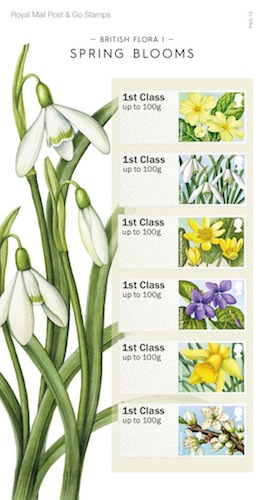
The labels will be used in Post & Go machines at Post Offices around
the country, and from the Royal Mail Series II machines at Spring Stampex.
A mint set of 6 x 1st will also be available from Royal Mail's Tallents
House Bureau in a pack similar to a presentation pack. All values in
the pack are 1st Class with a philatelic branch code.
Royal Mail will again produce a First Day Cover and official First Day
Postmarks for these.
Special Postmarks
Postmarks available for the day of issue will be shown here These are
not to scale. These postmarks cannot be obtained after the date
of issue.
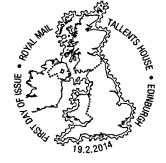
|
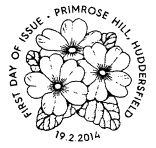
|
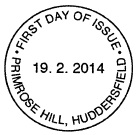
|
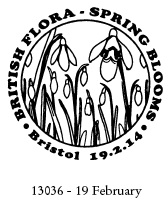
|
Ref FD1403TH
Philatelic Bureau Official Postmark illustrated with a map of the
British Isles |
Ref FD1403PL
Primrose Hill, Huddersfield
|
Ref FD1403NP
Primrose Hill, Huddersfield |
Ref W13036 - Bristol
|
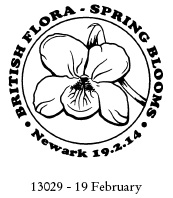
|
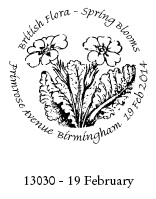 |
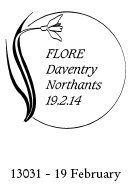
|
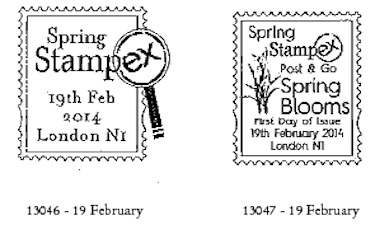
|
Ref N13029 - Newark
|
Ref M13030 - Primrose Avenue, Birmingham |
Ref M13031 - Flore, Daventry
|
L 13046 Generic Spring Stampex postmark
L 13047 Spring Stampex Spring Blooms first day postmark London N1
|
This page updated 3 March 2014
If you wish to be told when this page is updated, please use the
ChangeDetection box at the top of this page.
If you have any questions, please email
us.
NB: all emails will be acknowledged in 1-2 days
unless we are away (see home page). If you do not receive an
acknowledgement please email us from a different address (eg hotmail,
gmail).
Instant
Printing Prices from Webmart
Instant
Printing Prices from Webmart
